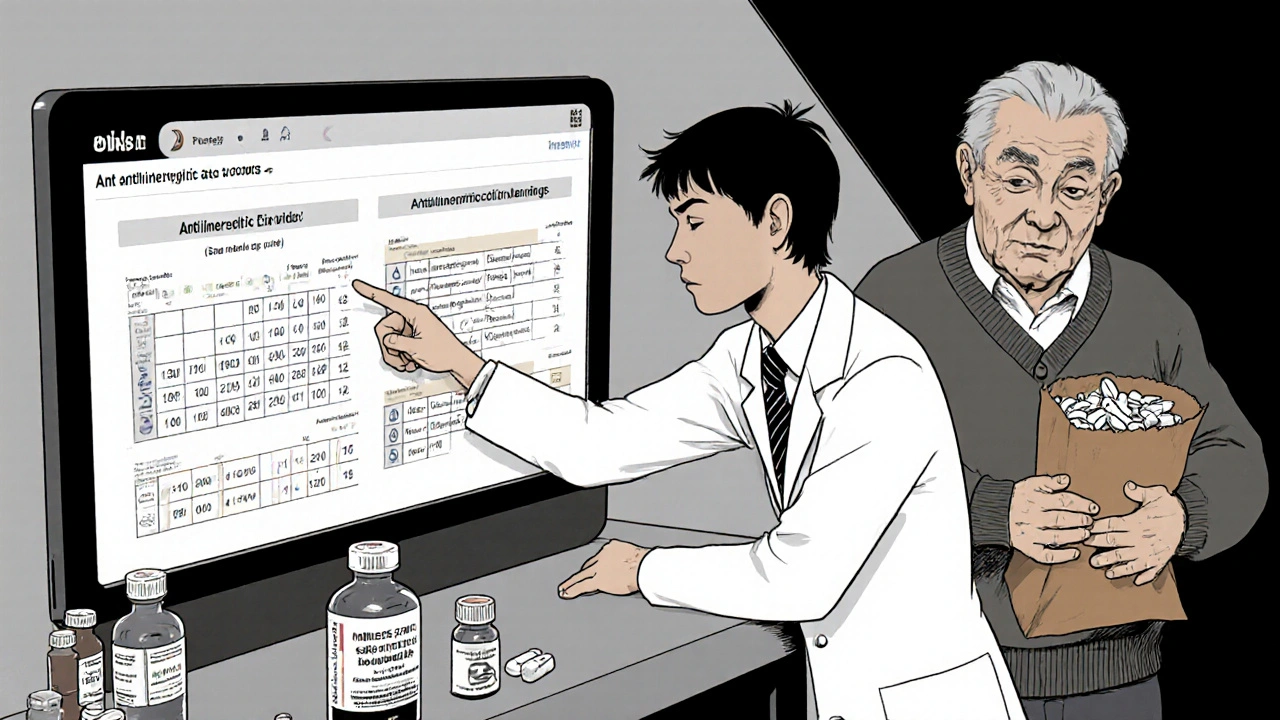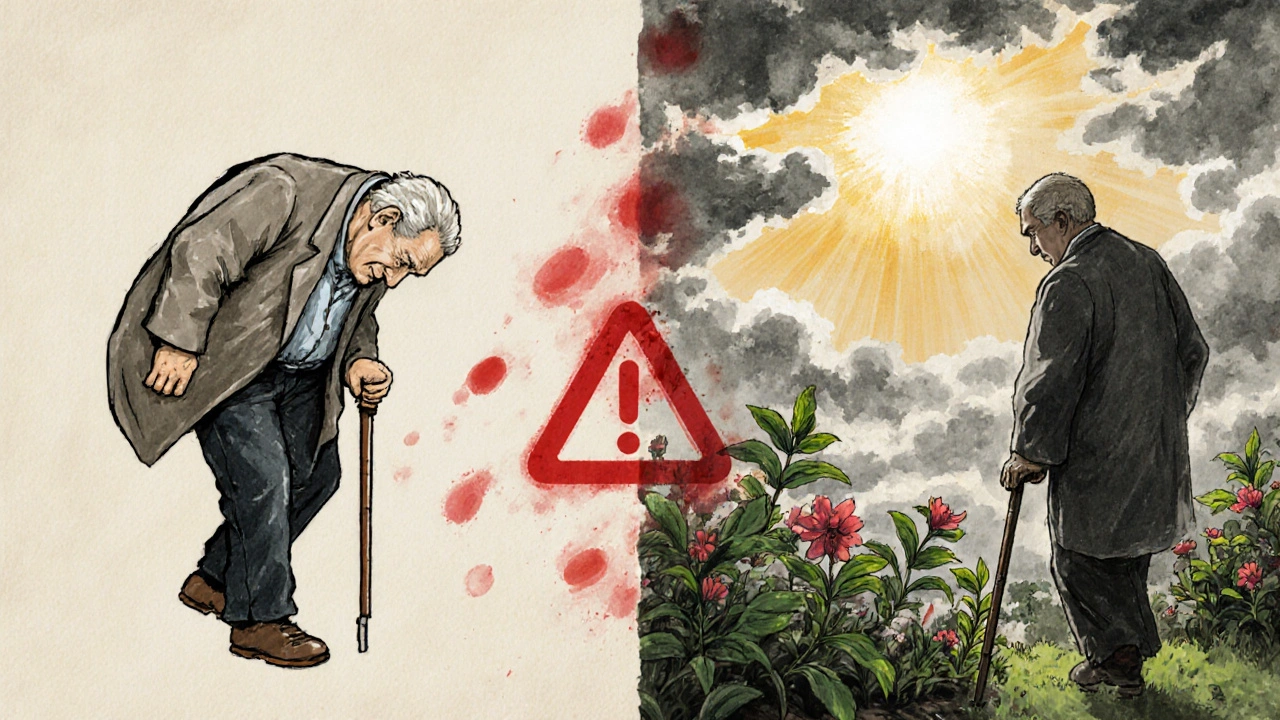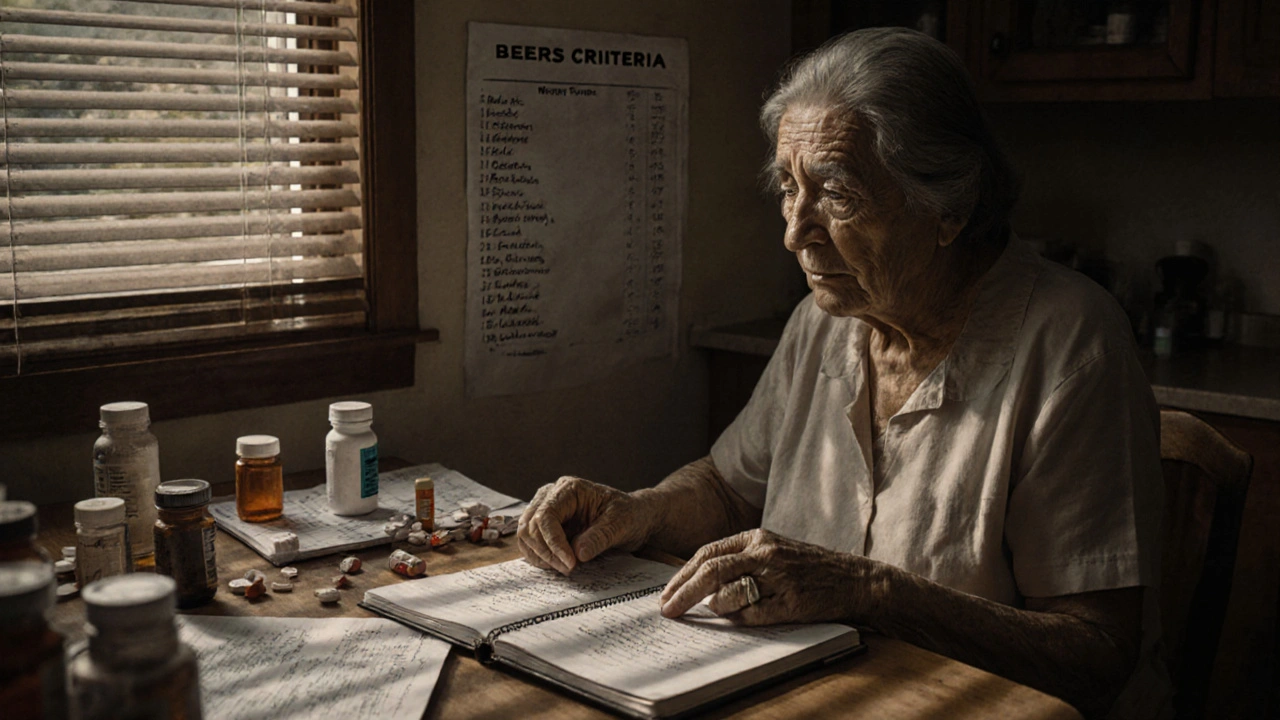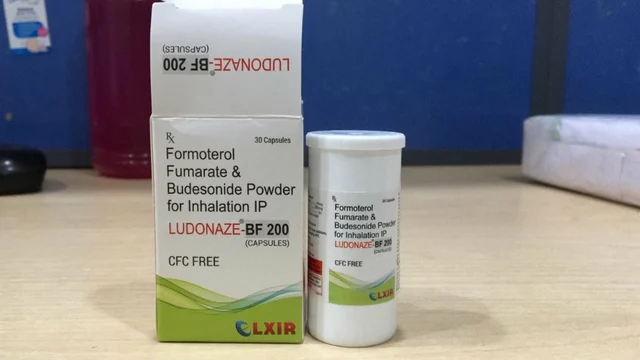More than one in three seniors in the U.S. are taking at least one medication that could do more harm than good. It’s not that doctors are being careless. It’s that many drugs prescribed decades ago were never tested on people over 65-and aging changes how the body handles medicine. What was safe for a 45-year-old can be dangerous for a 75-year-old. The Beers Criteria, updated in 2023 by the American Geriatrics Society, is the gold standard for spotting these risky drugs. It’s not a list of banned pills. It’s a warning system: these medications increase fall risk, confusion, kidney damage, and even death in older adults.
Why Seniors Are More Vulnerable
As we age, our bodies don’t process drugs the same way. The liver slows down. The kidneys filter less. Fat replaces muscle, so drugs that dissolve in fat stick around longer. At the same time, many seniors take five, six, or even ten different pills every day. That’s called polypharmacy-and it’s the biggest hidden danger. One drug can interact with another. A blood thinner can make a simple painkiller deadly. A sleep aid can turn into a fall risk overnight.Consider this: in 2022, adverse drug events sent nearly 1.3 million older adults to the emergency room. Medicare spent $177 billion that year treating these preventable problems. The good news? Most of these cases can be avoided with a simple medication review.
Top 5 High-Risk Medications for Seniors
- Zolpidem (Ambien®) - This sleep aid is one of the most commonly prescribed drugs for seniors. But it doesn’t wear off cleanly. Residual sedation can last up to 11 hours, leaving people groggy, unsteady, and prone to falls. Studies show seniors on zolpidem have an 82% higher chance of falling and breaking a hip. Worse, some report sleepwalking, confusion, or memory gaps the next day. For insomnia, safer alternatives include trazodone (used off-label) or non-drug approaches like cognitive behavioral therapy for insomnia (CBT-I).
- Glyburide (Diabeta®) - A sulfonylurea used for type 2 diabetes, glyburide is a ticking time bomb in older adults. It causes low blood sugar (hypoglycemia) in nearly 30% of seniors-compared to just 13% with glipizide. These episodes can lead to fainting, seizures, or strokes. The CDC and AGS both recommend avoiding glyburide entirely in people over 65. Glipizide or metformin are far safer choices with fewer side effects.
- Diphenhydramine (Benadryl®) - Found in sleep aids, allergy meds, and even some cold remedies, diphenhydramine is an anticholinergic drug. That means it blocks a brain chemical needed for memory and focus. Cumulative use over a year increases dementia risk by 54%. A 2015 JAMA study showed seniors who took it daily for more than three years had significantly worse cognitive decline. Even OTC versions are dangerous. Switch to loratadine (Claritin®) or cetirizine (Zyrtec®) for allergies, and avoid any product listing “PM” or “nighttime” on the label.
- Nitrofurantoin (Macrobid®) - Often prescribed for urinary tract infections (UTIs), this antibiotic becomes toxic when kidney function drops below 60 mL/min. In seniors with mild kidney disease-a common condition-it can cause scarring in the lungs. Mortality from acute lung reactions can hit 18%. For UTIs, alternatives like fosfomycin or nitroxoline are safer, especially if kidney function is already low.
- Alpha-1 blockers (Doxazosin, Terazosin) - These are sometimes used for enlarged prostate or high blood pressure. But they cause sudden drops in blood pressure when standing up. About 25% of seniors on these drugs experience dizziness or fainting. That’s more than three times higher than with chlorthalidone or ACE inhibitors. If you’re taking one of these, ask your doctor if a safer option exists.
What About Benzodiazepines and Antidepressants?
Benzodiazepines like lorazepam (Ativan®) and alprazolam (Xanax®) are another major concern. Even short-term use increases fall risk by 60%. Long-term use raises the risk of dementia and death. The 2023 Beers Criteria now explicitly warns against using them for insomnia in seniors. For anxiety or sleep, try non-drug therapies first. If medication is needed, low-dose trazodone or mirtazapine are better options.Tricyclic antidepressants like amitriptyline (Elavil®) are also on the high-risk list. They’re old, cheap, and still prescribed for nerve pain or depression. But they carry a 2.3-fold higher risk of dementia over seven years. They also cause dry mouth, constipation, urinary retention, and confusion. Newer SSRIs like sertraline or citalopram are much safer for seniors, with fewer side effects and better long-term outcomes.

How to Do a Medication Review
You don’t need a PhD to protect yourself or a loved one. Here’s how to start:- Collect every pill. Bring all medications-prescription, OTC, supplements, and herbal remedies-to your next doctor’s visit. This is called a “brown bag review.”
- Ask three questions:
- “Is this drug still necessary?”
- “Is there a safer alternative?”
- “Could this interact with anything else I’m taking?”
- Check the anticholinergic burden. If you’re taking two or more drugs with anticholinergic effects (like diphenhydramine, oxybutynin, or certain antidepressants), your risk rises fast. Use the Anticholinergic Risk Scale (ARS) to score your meds. A score above 3 means it’s time to talk to your doctor.
- Ask for a pharmacist consult. Many Medicare plans offer free Medication Therapy Management (MTM) services. A clinical pharmacist can spot hidden risks you and your doctor might miss.
- Don’t stop cold turkey. Some drugs-like benzodiazepines or antidepressants-need to be tapered slowly. Stopping suddenly can cause seizures, panic attacks, or rebound insomnia. Always work with your provider on a safe plan.
What’s Changing in 2025?
Medicare Advantage plans now use the 2023 Beers Criteria to set their formularies. That means if you’re on a Medicare plan, your insurer may already block high-risk drugs unless your doctor gets special approval. Electronic health records from Epic and Cerner now auto-flag risky prescriptions for patients over 65. Pharmacies using Surescripts’ Real-Time Prescription Benefit tool will warn you before filling a dangerous combo.There’s also a new CMS program called “Medication Safety for Seniors,” launched in January 2024. It ties 5% of Medicare Advantage bonuses to how well plans reduce high-risk prescriptions. That means insurers are now financially motivated to help you switch to safer drugs.

Real Stories, Real Results
One 78-year-old woman in Ohio was taking glyburide, diphenhydramine, and zolpidem. She kept falling, forgetting names, and feeling exhausted. After switching to glipizide, loratadine, and CBT-I for sleep, she went from three falls in six months to zero. Her blood sugar stabilized. Her memory improved. She started gardening again.A man in Florida was on doxazosin for prostate issues. He fainted twice walking to the bathroom. His doctor switched him to tamsulosin, which doesn’t drop blood pressure as much. He hasn’t had another episode.
These aren’t rare cases. They’re the norm. And they’re preventable.
What You Can Do Today
- Write down every medication you take, including doses and why you take them. - Ask your pharmacist for an anticholinergic burden score. - Request a medication review with your doctor-don’t wait for your annual checkup. - If you’re on a high-risk drug, ask: “What’s the plan if I stop this?” - Share this list with a family member. Two sets of eyes are better than one.Medications aren’t harmless. Especially for seniors. The goal isn’t to avoid all drugs-it’s to use the right ones, at the right dose, for the right reason. A simple review can mean the difference between staying independent and ending up in the hospital. Don’t wait for a fall, a fainting spell, or a memory scare to act. Start today.
What is the Beers Criteria and why does it matter for seniors?
The Beers Criteria is a list of medications that are potentially inappropriate for adults aged 65 and older because they carry higher risks of side effects like falls, confusion, kidney damage, or death. Updated every two years by the American Geriatrics Society, it’s based on decades of clinical research. It’s used by doctors, pharmacists, and Medicare plans to guide safer prescribing. If a drug is on the list, it doesn’t mean it’s always banned-but it means the risks usually outweigh the benefits for most older adults.
Can I stop taking a high-risk medication on my own?
No. Stopping some medications suddenly-especially benzodiazepines, antidepressants, or steroids-can cause serious withdrawal symptoms like seizures, anxiety, or rebound insomnia. Always talk to your doctor before making changes. They can help you taper off safely and replace the drug with a safer alternative if needed.
Are over-the-counter (OTC) drugs really dangerous for seniors?
Yes. Many OTC drugs like diphenhydramine (Benadryl®), promethazine (Phenergan®), and even some sleep aids contain strong anticholinergic ingredients. These can cause confusion, constipation, urinary retention, and increase dementia risk over time. Just because a drug is sold without a prescription doesn’t mean it’s safe for seniors. Always check labels and ask your pharmacist before using any OTC product.
How often should seniors have their medications reviewed?
At least once a year, but every 3-6 months is better if you’re taking five or more medications, have a chronic condition like diabetes or kidney disease, or have recently been hospitalized. Seniors over 75 should have a formal “brown bag” review with their doctor or pharmacist at least quarterly.
Does Medicare cover medication reviews?
Yes. Medicare Part D offers a free service called Medication Therapy Management (MTM) for beneficiaries who take multiple chronic disease medications, have high drug costs, or are at risk for adverse events. You can request a session with a clinical pharmacist who will review all your meds, check for interactions, and suggest safer alternatives. Ask your pharmacy or call 1-800-MEDICARE to see if you qualify.
What are the safest alternatives to common high-risk drugs?
For sleep: Try trazodone, melatonin, or CBT-I instead of zolpidem. For allergies: Use loratadine or cetirizine instead of diphenhydramine. For diabetes: Choose glipizide or metformin over glyburide. For UTIs: Fosfomycin or nitroxoline are safer than nitrofurantoin if kidney function is low. For anxiety or depression: SSRIs like sertraline or escitalopram are preferred over tricyclics or benzodiazepines. Always discuss alternatives with your doctor.






akhilesh jha
24 November 2025 - 01:15 AM
I’ve seen this happen with my dad. He was on glyburide for years, no one ever questioned it. Then he passed out at the grocery store. Turned out his blood sugar dropped so low he couldn’t stand. We switched him to metformin and he’s been fine since. Just wish doctors asked more before prescribing.
Jeff Hicken
25 November 2025 - 15:14 PM
so like… benadryl is bad?? no way. i’ve been taking it since i was 12. it’s the only thing that helps me sleep. now u say it causes dementia?? i’m gonna need a minute. also who wrote this like a textbook??
Vineeta Puri
26 November 2025 - 11:06 AM
Thank you for this thorough and compassionate overview. As a geriatric care coordinator, I see daily how easily seniors are placed on polypharmacy regimens without adequate review. The Beers Criteria is not a restriction-it is a lifeline. I encourage every family to conduct a brown bag review with their pharmacist. Even a single conversation can prevent hospitalization. Small steps, great impact.
Victoria Stanley
27 November 2025 - 04:39 AM
My grandma took diphenhydramine for years because she thought it was "just an allergy pill." She didn’t realize it was in half her meds. After switching to Claritin and stopping the nighttime stuff, her memory came back a little. She started recognizing my kids again. It’s not magic-it’s just stopping the stuff that’s fogging her brain.
stephanie Hill
28 November 2025 - 17:03 PM
Did you know Big Pharma pays doctors to keep prescribing these drugs? The Beers Criteria? They call it "guidelines" but it’s really a threat to profits. That’s why your doctor won’t listen. They’re getting kickbacks. And don’t get me started on Medicare Advantage-they’re cutting your meds to save money, not to protect you. Read the fine print. They’re not your friends.
Nikki C
29 November 2025 - 15:36 PM
we don’t need more lists we need more listening
old people aren’t broken prescriptions
they’re people who’ve been told for decades that their body is the problem
not the system
Alex Dubrovin
29 November 2025 - 22:05 PM
just talked to my mom about this today she’s on zolpidem and diphenhydramine and didnt even know they were on the list
we’re gonna do the brown bag thing next week
thanks for the push
Jacob McConaghy
30 November 2025 - 13:18 PM
Victoria’s comment hit home. My aunt went from falling every other week to zero after ditching doxazosin for tamsulosin. She’s gardening again. No drama. No hype. Just a simple switch. This isn’t about fear-it’s about respect. We owe our elders better than outdated scripts and silent side effects. Let’s start treating their bodies like they matter.